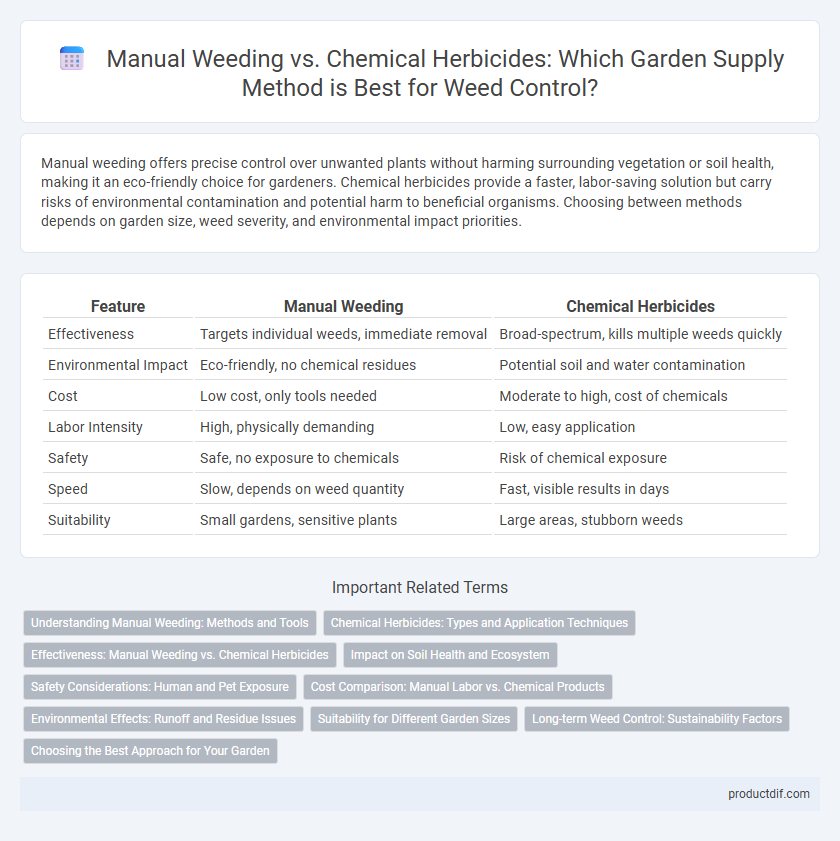Manual weeding offers precise control over unwanted plants without harming surrounding vegetation or soil health, making it an eco-friendly choice for gardeners. Chemical herbicides provide a faster, labor-saving solution but carry risks of environmental contamination and potential harm to beneficial organisms. Choosing between methods depends on garden size, weed severity, and environmental impact priorities.
Table of Comparison
| Feature | Manual Weeding | Chemical Herbicides |
|---|---|---|
| Effectiveness | Targets individual weeds, immediate removal | Broad-spectrum, kills multiple weeds quickly |
| Environmental Impact | Eco-friendly, no chemical residues | Potential soil and water contamination |
| Cost | Low cost, only tools needed | Moderate to high, cost of chemicals |
| Labor Intensity | High, physically demanding | Low, easy application |
| Safety | Safe, no exposure to chemicals | Risk of chemical exposure |
| Speed | Slow, depends on weed quantity | Fast, visible results in days |
| Suitability | Small gardens, sensitive plants | Large areas, stubborn weeds |
Understanding Manual Weeding: Methods and Tools
Manual weeding involves physically removing unwanted plants by hand or with simple tools such as hoes, hand forks, and weed pullers, enabling precise control over weed removal without damaging desirable plants. This method promotes soil health by maintaining its natural structure and avoiding chemical residues, making it ideal for organic gardening and small-scale gardens. Using ergonomic tools reduces physical strain and increases efficiency, ensuring effective root extraction to prevent regrowth and maintain garden aesthetics.
Chemical Herbicides: Types and Application Techniques
Chemical herbicides used in garden supply include selective herbicides targeting specific weeds and non-selective herbicides that eliminate all vegetation. Common types encompass systemic herbicides absorbed by plant roots and contact herbicides affecting only the treated foliage. Effective application techniques involve calibrated sprayers for uniform coverage, adherence to manufacturer-recommended doses, and timing applications during active weed growth to maximize efficacy.
Effectiveness: Manual Weeding vs. Chemical Herbicides
Manual weeding offers precise removal of weeds without harming surrounding plants, making it effective for small gardens and organic practices. Chemical herbicides provide rapid and broad-spectrum weed control, ideal for large-scale infestations but may pose risks to soil health and beneficial organisms. Effectiveness depends on garden size, weed type, and environmental considerations, with integrated approaches often yielding optimal results.
Impact on Soil Health and Ecosystem
Manual weeding preserves soil structure and microbial diversity by avoiding chemical residues, promoting long-term soil fertility and ecosystem balance. Chemical herbicides can disrupt soil biota, reduce beneficial microorganisms, and cause runoff that harms aquatic ecosystems. Sustainable garden supply choices favor manual weed removal to maintain healthy soil ecology and prevent environmental contamination.
Safety Considerations: Human and Pet Exposure
Manual weeding minimizes exposure to harmful chemicals, making it a safer option for households with children and pets. Chemical herbicides pose risks such as skin irritation, respiratory issues, and potential toxicity if ingested by humans or animals. Proper protective gear and strict adherence to application guidelines are essential when using chemical treatments to reduce health hazards.
Cost Comparison: Manual Labor vs. Chemical Products
Manual weeding requires significant time investment but has minimal financial cost, primarily limited to purchasing basic tools such as hoes or hand weeders. Chemical herbicides involve upfront expenses for products, which can vary widely depending on the brand, formulation, and application rates, often making them more costly in terms of materials. Over time, manual labor may be more economical for small gardens, while chemical herbicides might offer cost efficiency for larger areas due to reduced labor demand.
Environmental Effects: Runoff and Residue Issues
Manual weeding eliminates the risk of chemical runoff and harmful residues in soil and water systems, promoting a healthier garden ecosystem. Chemical herbicides often contribute to runoff that contaminates nearby water bodies, leading to toxicity in aquatic life and disruption of natural habitats. Residual chemicals can persist in soil, affecting beneficial microorganisms and reducing long-term soil fertility.
Suitability for Different Garden Sizes
Manual weeding offers precise control ideal for small to medium-sized gardens where close attention to individual plants is possible. Chemical herbicides provide efficient weed management for large-scale gardens or commercial landscapes but require careful application to avoid damage to desirable plants and the environment. Selecting between manual and chemical methods depends on garden size, weed density, and the gardener's preference for natural or chemical solutions.
Long-term Weed Control: Sustainability Factors
Manual weeding offers sustainable long-term weed control by minimizing soil disturbance and preventing chemical buildup, preserving soil health and biodiversity. Chemical herbicides provide quick results but can lead to resistant weed species, soil degradation, and negative environmental impacts over time. Integrating manual weeding with targeted, reduced herbicide use enhances sustainability and long-term garden productivity.
Choosing the Best Approach for Your Garden
Manual weeding offers precise control by physically removing weeds without harming surrounding plants, making it ideal for small gardens or organic practices. Chemical herbicides provide fast and widespread weed control, especially effective for large areas with persistent weed problems. Selecting the best approach depends on garden size, plant types, environmental impact considerations, and the need for immediate versus long-term weed management.
Manual Weeding vs Chemical Herbicides Infographic

 productdif.com
productdif.com